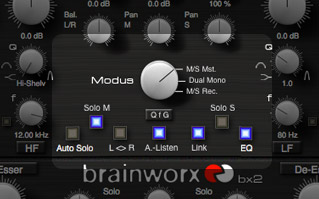
Legato is especially useful when you want the chords to glide but not the lead, thus saving you from creating two patches – one for the chords and the other for the lead. Portamento and Legato have also been added to custom tune those glide transitions between notes. This feature allowed bx_oberhausen to maintain its original “quirky” nature while you preserve your hearing when switching between presets. The General section adds a master level knob to wrangle those gain increases that occur when you turn controls up. Each area of the main section is loaded with new tricks to bring this synth into the DAW age. The Main section is very similar to the original SEM unit with 2 VCOs, Envelope controllers, and VCF.

bx_oberhausen accomplishes organization by keeping the Main Section visible and integrating a tabbed top section for effects, arpeggiator, and modulation control. The most used parts can stay prominently featured while others can pop up very quickly. While all of those sections seem daunting, Brainworx thought out the interface masterfully. The interface divides itself into six sections: The Main, Effects, Arpeggiator, Modulation, Preset Management, and Midi Learn / Toolbar Sections. There’s not a massive array of knobs and buttons like modern synths, but a ton of functionality and versatility. What makes this such a great synth to kick off the Brainworx virtual instrument line is the simplicity of integrating the Oberheim controls into the interface. The bx_oberhausen borrows heavily from the Oberheim SEM, all while adding a bevy of features that players in the ’70s could only dream of. It seems Brainworx had an affinity for these units as well, given their first foray into virtual instruments pays homage to the Oberheim name. The 9-year-old version of this writer could turn knobs and get some fun sounds. This affinity is partially due to the unintimidating nature and sheer versatility of the controls. Out of all of the different toys in that studio, I especially loved the Oberheim SEM (Synthesizer Expander Module), with its massive stacked pads and warm buzzing leads.

Nevertheless, dad’s friend had quite a few different synths as well as a Rhodes. This was back in the day where home studios were as uncommon as owning more than one analog synth. Growing up, my dad and his best friend would spend almost every Friday night in his friend’s home studio. This synth has an extraordinary place in my heart. Oberheim Electronics defined the sound of the ’70s and continues to make a big comeback in modern music. But is it enough to take on heavy hitters already in the virtual instrument arena? Let’s find out.

This unique perspective and countless incredible models of analog processors brings a different outlook as well as an arsenal of processing plugins to integrate. Brainworx is going in the opposite direction by being a plugin company venturing into soft-synths. In our review of Arturia’s 3 Compressors You’ll Actually Use, you see the typical transition of a virtual instrument company moving into the plugin space.


 0 kommentar(er)
0 kommentar(er)
